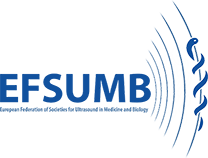- European Federation of Societies for Ultrasound in Medicine and Biology ~ Educating all for competence to practice ultrasound safely
The Use of Artificial Intelligence in the Evaluation of Knee Pathology
June 16, 2020Correlation Between Brain Tissue Damage and Inertial Cavitation Dose Quantified Using Passive Cavitation Imaging
June 16, 2020Quantification in Musculoskeletal Imaging Using Computational Analysis and Machine Learning: Segmentation and Radiomics
| Overview | The use of quantitative analyses has been slow in translating into the clinical practice of MSK imaging, despite the general agreement that it increases the value of imaging examinations. This is at least partly due to the difficulties posed by image segmentation, a crucial step in the processing pipeline for extracting quantitative information from regions of interest in the image. Progress has been slow in automatizing this task, and segmentation remains challenging. However, atlas-based methods and deep learning approaches have recently shown promising results. The next step of the radiomics pipeline consists of features extraction, leading to virtually an infinite number of features that may be analyzed in association with other non–imaging derived information to build decision-making models.
|
| Authors | Meritxell Bach Cuadra, Julien Favre, Patrick Omoumi.
|
| Journal | Seminars in Musculoskeletal Radiology Vol. 24 No. 1/2020 |
| Recommendation/Comment | This article is of interest to sonographers expert in ultrasound MSK |
| Clinical implication | MSK imaging has been lagging behind other subspecialties in the adoption of radiomics, as shown by the literature. Apart from oncology, imaging of osteoporosis and OA will most likely be the first to benefit from these new tools. |
| Link (DOI) | https://doi.org/10.1055/s-0039-3400268 |
| Ultrasound speciality | Musculoskeletal sonography – orthopaedics and traumatology |
Abstract: Although still limited in clinical practice, quantitative analysis is expected to increase the value of musculoskeletal (MSK) imaging. Segmentation aims at isolating the tissues and/or regions of interest in the image and is crucial to the extraction of quantitative features such as size, signal intensity, or image texture. These features may serve to support the diagnosis and monitoring of disease. Radiomics refers to the process of extracting large amounts of features from radiologic images and combining them with clinical, biological, genetic, or any other type of complementary data to build diagnostic, prognostic, or predictive models. The advent of machine learning offers promising prospects for automatic segmentation and integration of large amounts of data. We present commonly used segmentation methods and describe the radiomics pipeline, highlighting the challenges to overcome for adoption in clinical practice. We provide some examples of applications from the MSK literature.
Keywords: artificial intelligence, radiomics, musculoskeletal, imaging, radiology.

